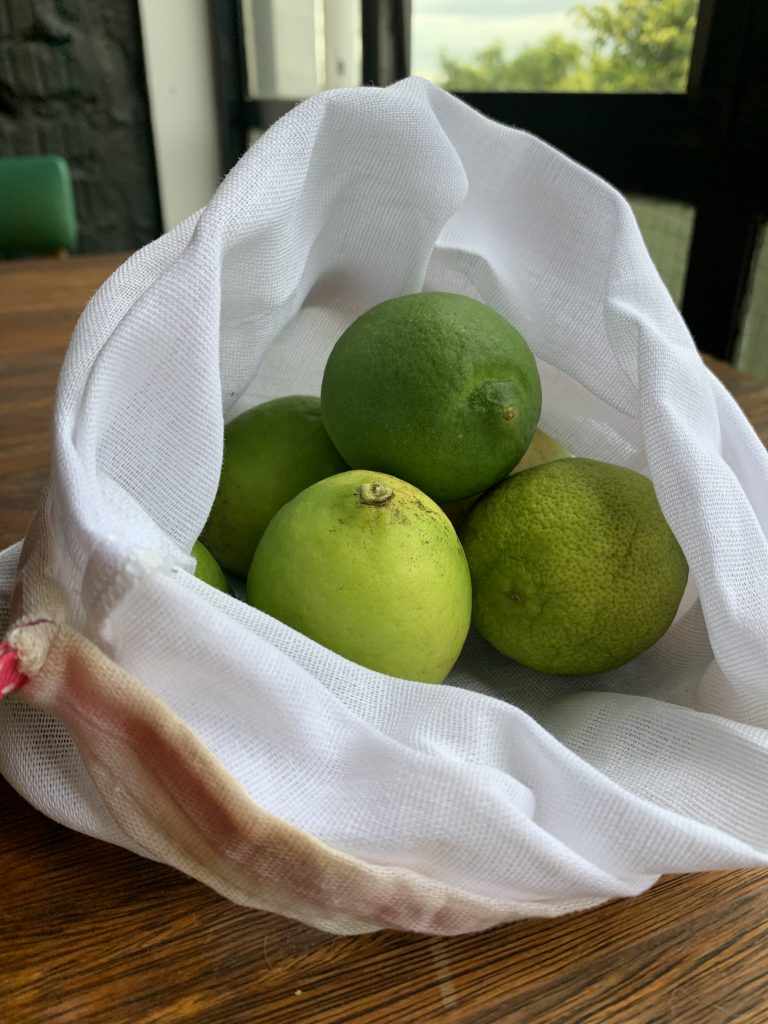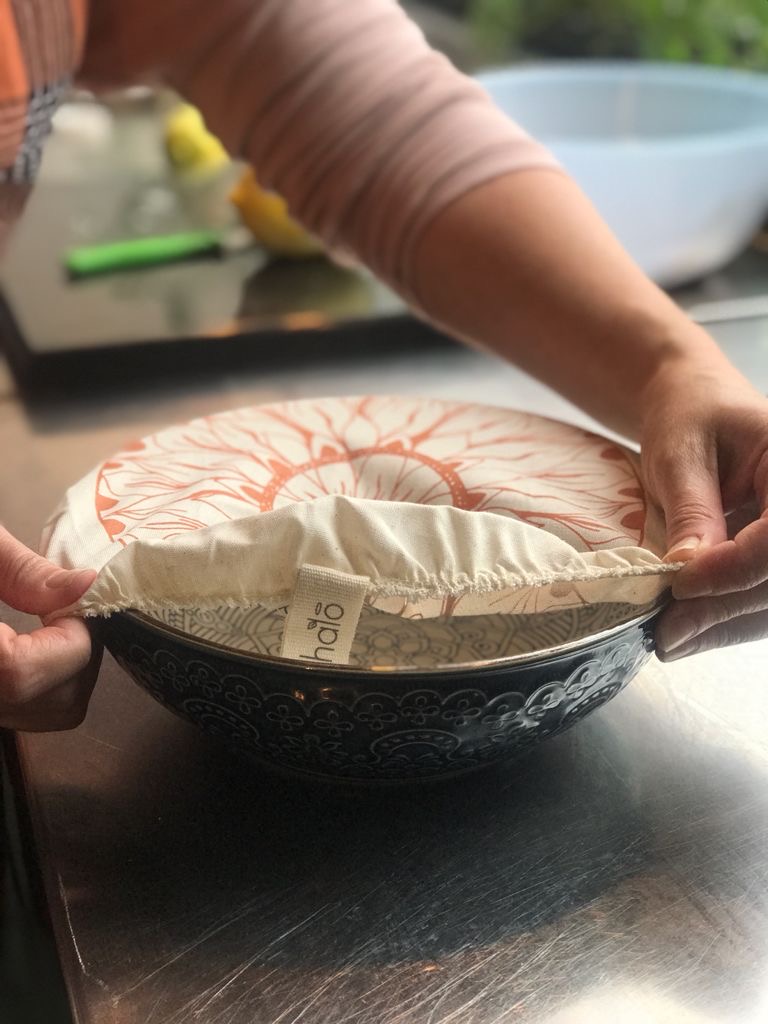One of my goals for this year is to keep my fridge as plastic free as possible. Making your fridge plastic-free does take time and effort, but I have learned that a few small changes to your shopping habits already make a huge difference. Add a few storage tweaks, and before you know it, you are well on your way to a plastic free fridge. Remember, like all changes we make in our lives perfection is not possible (and also not the goal) here. I love Anne-Marie Bonneau’s wisdom: ‘We don’t need a handful people doing zero waste perfectly. We need millions of people doing it imperfectly.’ Remember every swap we make is a win. Whatever you choose to do, be realistic. Set yourself up for success.
The words WHERE, WHAT and HOW have really helped me transform my fridge from a wasteland of plastic and rotten produce into an organized and waste free space. A plastic-free fridge is possible, and this is how.
- WHERE I shop makes a difference
Farmers Markets’ produce often come in less plastic making it a great choice when trying to cut back on single use plastic. I realize not everyone has access to a local farmers market, but if you are able to find one in your area, give it a go!
Tip: Get to the Farmers Market early and buy in bulk (but only if you have time to freeze or preserve the produce that you do not use).
It is also worth while finding out if there are any vegetable gardeners in your area. Many times, vegetable gardeners have to much produce and are prepared to sell their produce or swap it for other goods. Buying from local gardeners is great because the produce is well priced, and you know it has not been stored in large, refrigerated warehouses for who knows how long. Another benefit to shopping locally is you get to eat seasonally. Eating like this helps to reduce greenhouse gas emissions that come from shipping food all over the world.
In America alone approximately 258 million kilograms of non-reusable packaging is discarded each day. We need to cut back on single-use plastic packaging. Weigh-and-pay stores are a great way of doing that. Many of them allow you to bring your own jars and bottles which means you are only paying for the food you buy, and you are taking less plastic home to your fridge. If you live in Johannesburg it is worth your while to visit https://therefillery.co.za/. They have stores in Morningside and Fourways. You can also stock and re-stock your pantry and fridge on their online store. They are also opening a store in Pretoria at the end of February 2021 which I cannot wait to visit!
When shopping at a grocery store and trying to cut back on plastic packaging it is worth investing in a few mesh and muslin bags. You can buy them from https://theunwrappedco.co.za/, https://www.biddykins.co.za/ or https://www.faithful-to-nature.co.za/

Start in the produce section. Look for naked food, this is food that has ZERO wrappings on it, like bananas. I use my mesh bags for heavier items like potatoes, apples etc. Mesh bags will make life easier for you at the checkout because the cashier can see through the bag easily. For items like leafy greens and mushrooms, I use my muslin bags.
For baked goods, most grocery stores have a bakery section where you can buy baked goods that are not packaged in plastic.
Unfortunately buying meat and cheese, that is not prewrapped in clingwrap, is almost impossible in South Africa. Having said that there are some cheese counters and butcheries that are prepared to pack your cheese or meat in your own glass container, so ask. A quotation from Nora Roberts helps me in this regard: ‘If you don’t ask, the answer is always no.’
I want to warn you that you may run into trouble in some grocery stores when you are trying to do this. If you get a negative reaction, see it as the perfect opportunity to start a conversation with the shop owner or manager. Remember you are a paying customer which means you have a lot more power than you think. Most places want to make their customers happy. The more we speak up the more things will change. Always be polite. Be as clear as possible about what you expect but understand they are within their rights to refuse your reusable containers.
- WHAT I buy can bring about change
I grew up in a house of bargain hunters. My nanna and mom could not resist a good bargain, especially those ‘buy 2 get 1 free’- deals. The older I get the more I find myself falling into the same behaviour. Often, I catch myself buying two of a product to get one free, only to end up throwing a lot of what I bought away. This happens too often when it comes to fresh produce. I have come to realize that in my case, attempting to live a little greener, means buying less, and only when I need it.
Shopping is all about choices. What we buy can bring about change now and for the future. Remember we communicate to producers and shop owners every time we choose to buy or not to buy a product.
Only buy what you need. Opt for items that come in glass, aluminium or cardboard which can be recycled. Also think about what you might be able to make yourself, for example hummus or guacamole. If you must buy plastic look for the number 1 or 2 on the container – they usually have a higher recycling rate.
Tip: instead of buying yogurt in 6 single little plastic containers, opt for a larger container and split it into smaller containers at home. This way you are only throwing one piece of plastic away, and not six.
- HOW I store it is important.
I love glass boxes and containers – they are easy to clean, stack in the fridge and are prefect for leftovers. Glass boxes are great for storing fragile produce such as salad leaves, mushrooms and veggies that bruise easily if stored in bags or other less structured storage solutions.
Glass jars are also a great way to keep your fridge plastic-free. They can be used to store freshly picked parsley, chives, and herbs from the garden. I also store chocolate chips, dried berries, and soup in glass jars.
I have replaced cling wrap with fabric bowl covers and wax wraps in my fridge. Fabric bowl covers work very well when you need to cover a bowl of left-over veggies or salad. Wax wraps can wrap around almost anything. The are perfect for wrapping anything that likes to keep breathing (i.e., all fresh food). Wax wraps are reusable and last approximately one year, and because they are biodegradable can be composted.

Here are some other simple rules for storing fruit and veggies in the fridge:
I store most of my fruit at room temperate on the counter. If you buy fruit remember to eat it within a few days.
Store carrots and celery in jars of cold water in the fridge.
Store beets, cucumbers and green beans in open glass containers covered with a damp towel in the fridge.Store cauliflower, herbs, and cherries in closed glass containers in the fridge.
Store broccoli, snap peas, spinach, and cut melon in open glass containers in the fridge. Avocados, strawberries, figs, and any other berries can be stored in a paper bag in the fridge
Store greens in closed glass containers covered with a damp cloth in the fridge.
My fridge is a work in process (and so am I). I still have so much learn. Please share your favourite tips and tricks on storing food sustainably with. I would love to hear from you.
Here’s to a plastic-free fridge in 2021!
xxx

